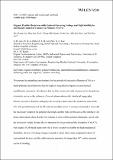Organic flexible memristor with reduced operating voltage and high stability by interfacial control of conductive filament growth
Abstract
Herein, the underlying mechanisms for the growth of conductive filaments (CFs) at a metal–polymer electrolyte interface through ion migration in organic electrochemical metallization (ECM) memristor are presented. It is observed that the free volume of voids (nanopores) in the polymer electrolyte serves as the pathways of metal‐cations whereas the interfacial topography between an active electrode and a polymer electrolyte determines the nucleation sites of the CFs. The growth kinetics of the CFs and the resultant resistive memory are found to vary with the molecular weight of the polymer electrolyte and the metal protrusions at the interface. Our direct observations show that the free volume of voids of the polymer electrolyte, varied with the molecular weight, dictates the ion transport for the growth and the disruption of the CFs. Our organic ECM‐based memristor with a hetero‐electrolyte exhibits high mechanical flexibility, low switching voltages reduced by about three times compared to those of conventional devices, and stable memory retention for longer than 104 s under repeated cycles of bending.
Citation
Lee , S-H , Park , H-L , Keum , C-M , Lee , I-H , Kim , M-H & Lee , S-D 2019 , ' Organic flexible memristor with reduced operating voltage and high stability by interfacial control of conductive filament growth ' , Physica Status Solidi - Rapid Research Letters , vol. Early View , 1900044 . https://doi.org/10.1002/pssr.201900044
Publication
Physica Status Solidi - Rapid Research Letters
Status
Peer reviewed
ISSN
1862-6254Type
Journal article
Description
This work was supported in part through the BK21 Program funded by Ministry of Education of Korea.Collections
Items in the St Andrews Research Repository are protected by copyright, with all rights reserved, unless otherwise indicated.

